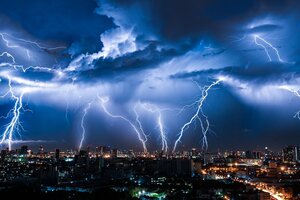Who Is in Need of Lightning Protection Company? Testing Ways
Corps
The dazzling streaks of electrifying energy illuminating the skies leave us in awe, reminding us of the tremendous power that lies dormant within the natural world. However, with this breathtaking spectacle comes a formidable threat that can wreak havoc on property.
As our societies continue to advance with rapid urbanization and technological progress, protecting against the devastating impact of lightning strikes has become imperative. Lightning Protection company stands as an essential defense mechanism and meticulously designed structures to shield us from the catastrophic force of nature.
Who Needs Lightning Protection System?
Industries:
Certain facilities are vital for uninterrupted operations, like:
- Water treatment works
- Power distribution centers
- Solar farms
Moreover, the system secures sensitive equipment, preventing damage and providing smooth functioning.
Residential:
From cozy homes to sprawling estates, the edifices deliver shelter for our families. Safeguarding them with a system not only guards them against harm but also offers peace of mind to those living within, knowing they are secure during thunderstorms.
Commercial:
Skyscrapers that touch the sky, bustling shopping centers, and business hubs all fall under the purview of its needs. Besides, these buildings often hold:
- Critical technological infrastructure
- Data centers
- Communication systems
An LPS provides continuous operation during storms:
- Preventing data loss
- Avoiding costly downtime
Telecommunication Towers:
As pillars of connectivity, cell phone towers and communication facilities are highly exposed to thunderbolts due to their height. The protection system shields these vital communication channels. Also, it keeps us connected even during the fiercest storms.
Types of Lightning Protection Tests:
To evaluate the performance of systems, several tests are conducted:
Continuity:
These tests verify that all components of the system, such as conductors, grounding electrodes, and bonding connections, are properly connected. Moreover, it shows the continuity in the system and guarantees a safe path for lightning currents to follow.
Resistance Measurements:
In electrical systems, one crucial aspect is assessing the electrical resistance present in different components. This evaluation is vital as it helps detect areas where high resistance might pose a problem for the effortless and quick dissipation of lightning currents.
By knowing these potential weak points, prompt corrective actions can be taken for the system's safety and optimal functionality during electrical storms. Further, this check-up helps to pinpoint any high-resistance areas that could impede the efficient dissipation of lightning currents, allowing for prompt corrective actions.
Surge Protection Device (SPD):
The effectiveness of surge protection given by these devices can be verified through rigorous testing procedures. Any issues or malfunctions can be promptly rectified, ensuring that the SPDs remain fully operational when needed most.
Bonding:
During bonding verification, specialized equipment is employed to measure the electrical continuity and impedance of the bonding connections. In this way, you can observe any weak spots or discontinuities in the system that could compromise its ability to handle the currents.
Moreover, qualified professionals, often lightning protection engineers or certified technicians, evaluate accurate results and proper assessment.
Ground Resistance:
The results of the ground resistance test can reveal areas of concern within the grounding system, such as:
- Poor soil conductivity
- Corroded grounding rods
It is important to note that it should be done periodically to monitor the grounding system's condition over time. Besides, corrective measures can be implemented to enhance the system's overall efficiency.
Voltage Stress:
It involves applying high-voltage surges to various components of the lightning protection system, including:
- Air terminals
- Down conductors
- Grounding electrodes
This process estimates how well these elements respond to the surge and whether they can divert the energy away from sensitive areas.
Environmental:
By subjecting these systems to simulated extreme weather conditions, professionals can observe their ability to withstand well in harsh climates. Through accelerated aging processes, the assessments demonstrate how components react to environmental stresses.
Moreover, these analyses extend to UV radiation, dust, and pollutants, impacting performance under specific conditions.
Specialist Lightning Protection
In the United Kingdom, while Lightning Protection is not mandated for all buildings, specific structures fall under the purview of HSE regulations, including:
The COMAH 2015 (Control of Major Accident Hazards) regulations
They primarily encompass the chemical industry, nuclear facilities, and power plants. However, these regulations also cover properties that store materials with volatile components. Additionally, they apply to various other industries that satisfy the specified threshold concerning harmful substances.
The DSEAR 2002 (Dangerous Substances and Explosive Atmospheres Regulations)
It aims to prevent or limit the harmful effects of fire and similar events, as well as the corrosion of metals. Besides, these regulations cover places that store or handle substances, for instance, petroleum, which are flammable or eruptive, and thus require proper measures.
Points to Remember
- Before allowing anyone into your home, ask for identification and verify that they are from the company responsible for incorporating the protection system.
- Also, ensure the arrival time and date match the scheduled appointment. You don't want to be caught off guard by unexpected visitors.
- Besides, check if they have easy access to your home and the areas where the lightning protection system needs to be installed. You better clear any obstacles or obstructions that could hinder their work.
- Speak with them about their installation plan and ask any questions about the process. One should understand what they will be doing and where experts will place the lightning protection components.
- Furthermore, lightning protection installation involves drilling and disturbances. Moving valuable or delicate items away from the installation areas is advised to avoid any accidental damage.
- Confirm that the team follows proper safety protocols while working on your property. Ask them to take necessary safety measures, such as wearing appropriate personal protective equipment.
- Moreover, keep children and pets away from the work areas for safety reasons. The installation process may involve hazardous tools and materials.
Wrap Up
Let us cherish the beauty of a lightning strike while acknowledging its potential for destruction. Through this dual lens, we forge a path of harmony with the forces that govern our planet.






commentaires